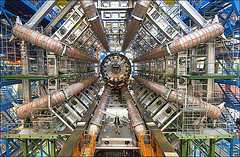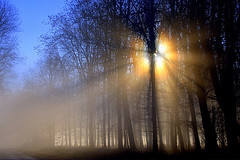June 30th, 2008 by Eugene Barsky | No Comments »

CNN runs an article today about the CERN’s Large Hadron Collider.
The article raises some fears that the Large Hadron Collider could exceed physicists’ wildest conjectures: Will it spawn a black hole that could swallow Earth? Or spit out particles that could turn the planet into a hot dead clump?
The article tries to answer those questions with CERN and other physicists. A very nice read – here is the full text – http://www.cnn.com/2008/TECH/06/30/doomsdaycollider.ap/index.html
The comments are open for any UBC folks that are willing to address this issue 🙂 After all, we have our own system here at UBC – at TRIUMF…
Thanks to Anne Miele for the link.
** Photo by Image Editor
Posted in General Science, Main, News, Physics, Science - undegraduate classes | No Comments »
June 25th, 2008 by Eugene Barsky | No Comments »
Rube Goldberg machine is a deliberately complicated apparatus that performs a very simple task in very indirect and convoluted fashion.
Many engineering schools have Rube Goldberg machine contests – see Purdue University site or University of Wisconsin Milwaukee site
I particularly like this Honda ad below that uses the Rube Goldberg machine principle 🙂
** Thanks to Sheryl Adam for the tip
Posted in General Science, Mechanical Engineering, Physics, Science - undegraduate classes | No Comments »
June 17th, 2008 by Eugene Barsky | No Comments »

The 13 June 2008 issue of Science features a special issue about forests in 21st century.
They called this issue Forests in Flux, and it could be of interest to all UBC people dealing with forestry, wood sciences and related areas 🙂
http://www.sciencemag.org/content/vol320/issue5882/index.dtl#special-issue
** Photo by Today is a good day
Posted in General Science, Science - undegraduate classes, Wood Sciences | No Comments »
June 11th, 2008 by Eugene Barsky | No Comments »

Here is another podcast we recorded back in April 2008. It is presented by Prof. Mark Halpern, from the UBC Physics and Astronomy Department.
Here is the abstract for this presentation:
The universe is filled with a thermal glow called the cosmic microwave background that comes from the hot plasma which filled it early on. Measurements of this background made by the NASA satellite WMAP have determined the age, geometry and composition of the universe with new precision, determining that the universe today is dominated by a dark energy that is causing it to expand ever more rapidly. The mission has also determined that baryonic matter–the atoms and molecules we see around us–only form a few percent of the total energy density of the universe today, and has determined the epoch at which the first stars formed. Recent results give a tantalizing picture of the first very small fraction of a second in the “big bang”. Six years after its launch WMAP remains healthy and the data continue to pour in. This talk will explain to a general audience what this experiment tells us about how the universe began and what it is made out of.
Here is the audio file – Measuring how the universe began
Here you can also find the PDF file of the presentation and the movie that Prof. Halpern demonstrated – https://circle.ubc.ca/handle/2429/660
** Photo by makelessnoise
Posted in General Science, Physics, Podcasts, Science - undegraduate classes | No Comments »
June 9th, 2008 by Kevin Lindstrom | No Comments »
UBC Department of Physics and Astronomy professor Dr. Ian Affleck has been recognized by the American Physical Society’s as one of their Outstanding Referees.
“The Outstanding Referee program was instituted in 2008. The highly selective award program recognizes scientists who have been exceptionally helpful in assessing manuscripts for publication in the APS journals. The program will annually recognize approximately 130 of the 42,000 currently active referees, but in the inaugural year a larger group of 534 referees has been selected for the Outstanding Referee designation. Like Fellowship in the APS, this is a lifetime award. By initiating the program, APS expresses its appreciation to all referees, whose efforts in peer review not only keep the standards of the journals at a high level, but in many cases also help authors to improve the quality and readability of their articles—even those that are not published by APS.”
Click here to read the full article.
Posted in General Science, News, Physics | No Comments »
June 6th, 2008 by Kevin Lindstrom | 1 Comment »
A team of physicists at the Californian Institute of Technology has claimed that our view of the early Universe may contain the signature of a time before the Big Bang.
Dr Adrienne Erickcek, and colleagues from the California Institute for Technology (Caltech), now believes these fluctuations contain hints that our Universe “bubbled off” from a previous one.
Their data comes from Nasa’s Wilkinson Microwave Anisotropy Probe (WMAP), which has been studying the Cosmic Microwage Background since its launch in 2001.
Their model suggests that new universes could be created spontaneously from apparently empty space. From inside the parent universe, the event would be surprisingly unspectacular.
Click here to read the full BBC news article
The preprint version of the article submitted to Physical Review Letters, A Hemispherical Power Asymmetry from Inflation is available at arxiv.org.
There is a UBC connection to this research. Dr. Mark Halpern from UBC’s Department of Physics and Astronomy is directly involved in
WMAP Research and is a member of the WMAP Science Team.
Posted in General Science, Main, Physics, Science - undegraduate classes | 1 Comment »
June 4th, 2008 by Eugene Barsky | No Comments »

This long awaited report by the US Climate Change Science Program analyzes the effects of global change on natural and human environments, agriculture, water resources, social systems, energy production and use, transportation, and human health. It analyzes current trends in global change, both natural and human-induced, and it projects major trends for the future.
On their site – http://www.climatescience.gov/Library/scientific-assessment/ you can find the full report, the executive summary and other related materials.
** Photo by Enzo D
Posted in Earth and Ocean Sciences, General Science, Main, News, Science - undegraduate classes | No Comments »
June 2nd, 2008 by Eugene Barsky | No Comments »

Brian Greene, a professor of physics at Columbia, and the author of The Elegant Universe and The Fabric of the Cosmos, writes about “the powerful role science can play in giving life context and meaning.”
Put a Little Science in Your Life
** photo by smiling_da_vinci
Posted in Main, News | No Comments »





